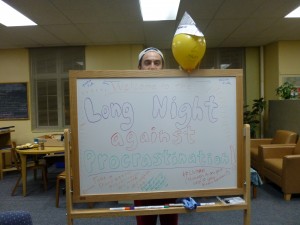by Jana Cary-Alvarez and Hannah Fattor, writing advisors
Jana is a history major and Hannah works in theatre and the classics, so we both deal with a lot of primary source material. Sometimes it’s difficult to know if you’re dealing with primary sources (what are they, anyway?) and sometimes it’s hard to analyze them (how am I supposed to know what people thought at the time?), but when you find a good one, it can be a wonderful resource.
What Are Primary Sources?
Sources from the time period you’re exploring! Playbills, propaganda posters, photographs, novels, bank notes, poems, songs, newspaper articles, plays, paintings, and so on. A primary source is something that reflects a contemporary sentiment. It has to be from the time period, though! Statistical data isn’t a primary source, unless it was available at that time and you look at the way it was presented to the public. Basically, once interpretation gets involved, the item is less likely to be a primary source. Since statistics are interpretations of different types of data, they aren’t primary sources except in very specific cases.
How Do You Work With Primary Sources?
The key to primary sources lies in how you analyze them. Look at how they functioned in their time period. Look at what they reveal about conventional thoughts, styles, biases, conflicts, opinions, and norms. A lot of the time primary sources are most valuable when you look at what they aren’t intentionally revealing. What do household appliance advertisements during the 1950s in the United States say about the role of women in the economy? The intention of such an advertisement is to sell appliances, not to demonstrate perceived gender norms, yet you can find that information there if you interrogate it enough.
What are a Primary Source’s Limitations?
It’s important to remember that a primary source is only one example from a time period and that it frequently needs to be supported by other primary sources and other scholarship if you’re going to make an overarching claim about society. That dishwasher advertisement might be a treasure trove of information about gender norms in the 1950s, but we may not know if this advertisement was standard or if it was going outside of normal advertising techniques. It’s important to know as much background information about the primary source as you can. The implications of our dishwasher ad might be different if it was printed by a mom & pop local store in Wilcox, Arizona than if it were an advertisement put in a nationally-run magazine from General Electric. Think about what those implications are.
Another limitation of primary sources emerges with translations. It may be tempting to do a word-by-word rhetorical analysis with a rich textual primary source, but if it has been translated into English from another language there are potential translation errors and the translator’s perceptions and interpretations between you and the original. There are concepts in Greek that can’t be fully translated into English, such as the various types of love. Familial affection, or στοργή, storgē, is completely different from erotic love, or ἔρως, érōs. Such nuances in language make a big difference in understanding how people are relating to each other in a Euripides play like Hippolytus! You can see Hannah’s earlier blog post on working with translations if you’re concerned about this at all. It’s something to keep in mind when working with something already interpreted by someone else, though. Reading more than one translation and comparing can be useful if you have the time; you want to be as close as possible to the original work. This means that adaptations of a play shouldn’t be used to analyze the original work.
The same goes for works of art adapted from originals. Adaptations tell you about the time period in which they were made, not the time period of the source work. Knowing that something is alluding to an earlier play or piece of art can be very useful, though! You can track the original story or picture and observe how the more modern artist altered it to suit a new time period and new aesthetic. Question why such changes were made, why some themes were preserved, how characters transformed, and how the new work would have been presented to a contemporary audience in contrast to how people would have seen the original. Why allude to the older work at all? What does the artist or writer gain from doing so?
Even with all of these limitations you may face when analyzing a primary source, they can tell you so much about a particular time period and the concerns people faced, the types of entertainment they enjoyed, how hierarchies within such a society emerged, what values and morals people held, what they liked to see in art galleries or in their living rooms, and how they understood themselves. History can seem strange at times, but finding primary sources proves that these oddities to us were normalities to other people.




